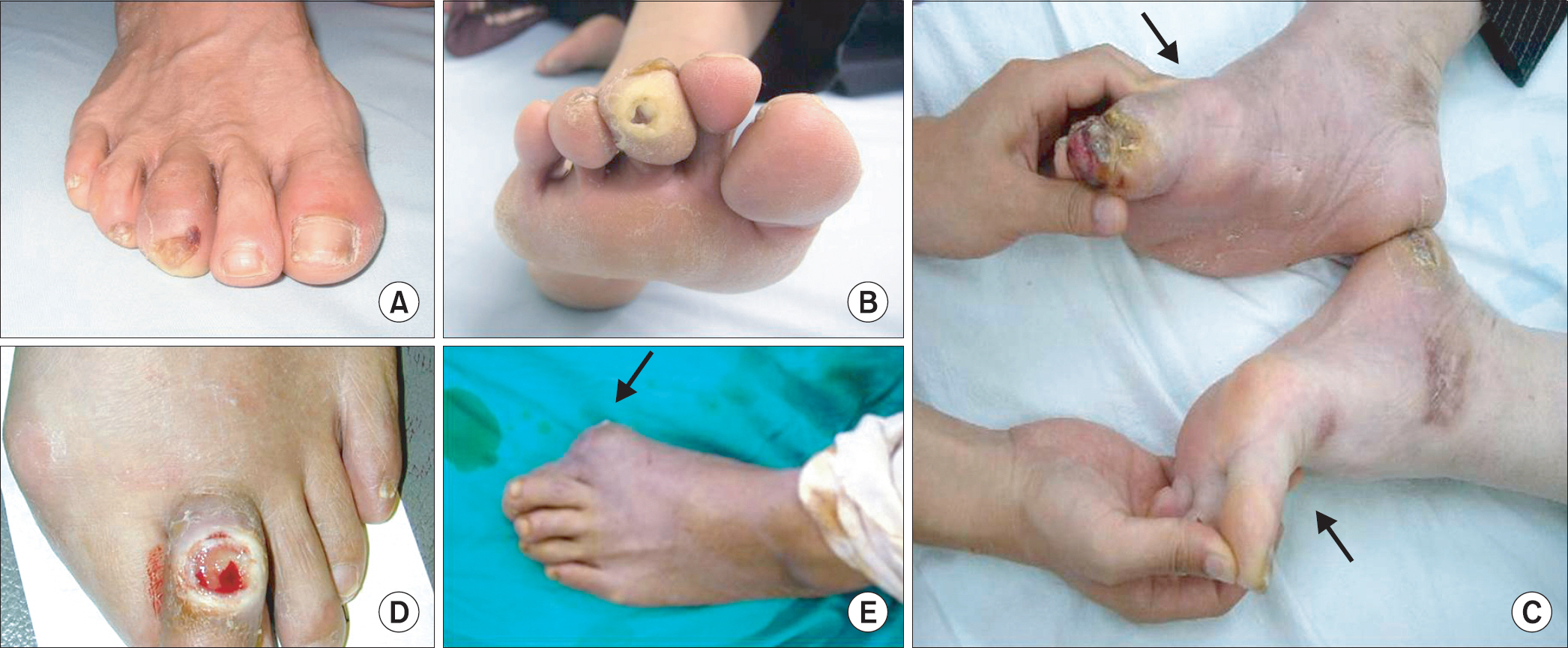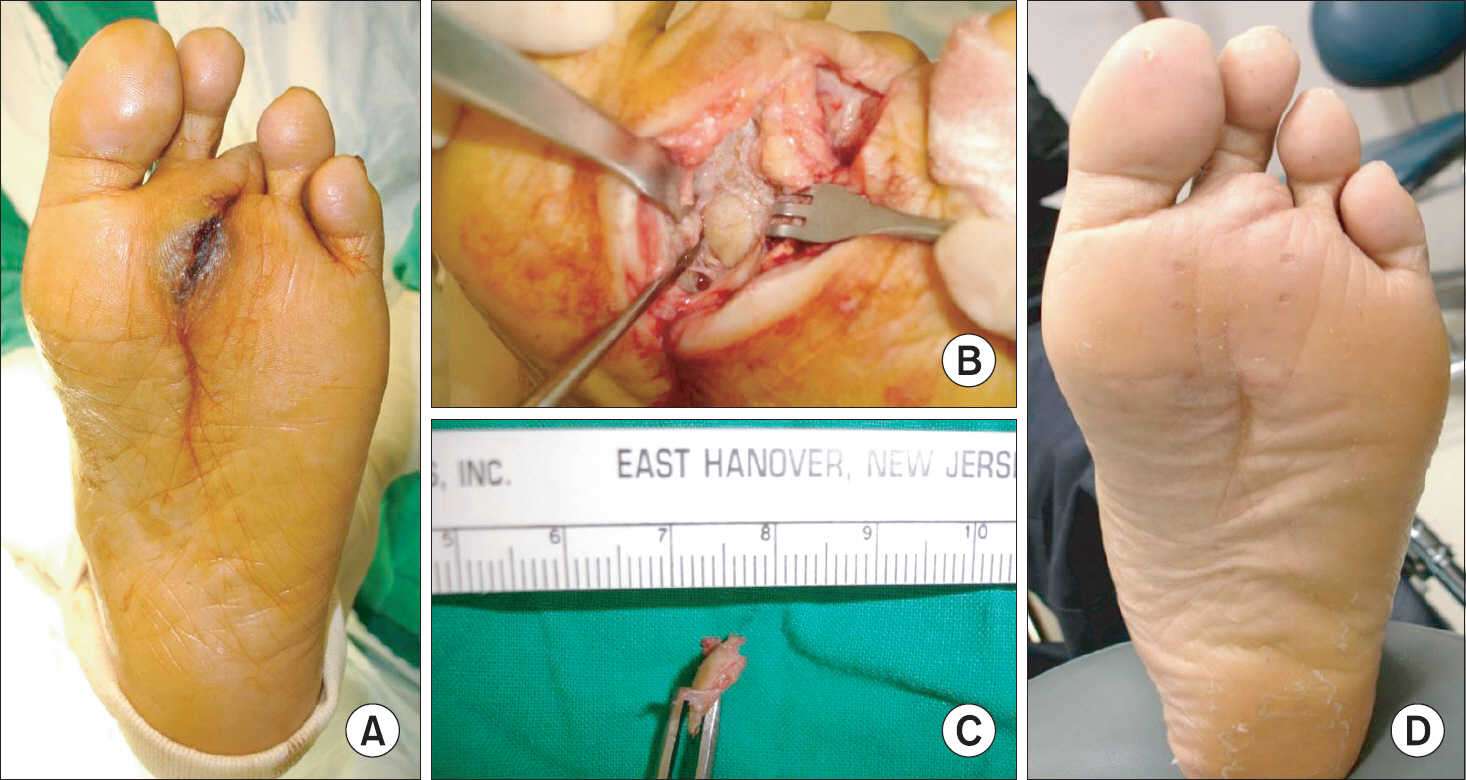Management of Diabetic Foot Ulcer
- Affiliations
-
- 1Department of Orthopaedic Surgery, Asan Medical Center, Ulsan University College of Medicine, Seoul, Korea. hosng@amc.seoul.kr
- KMID: 1958731
- DOI: http://doi.org/10.14193/jkfas.2014.18.1.1
Abstract
- In patients with diabetic foot, ulceration and amputation are the most serious consequences and can lead to morbidity and disability. Peripheral arterial sclerosis, peripheral neuropathy, and foot deformities are major causes of foot problems. Foot deformities, following autonomic and motor neuropathy, lead to development of over-pressured focal lesions causing the diabetic foot to be easily injured within the shoe while walking. Wound healing in these patients can be difficult due to impaired phagocytic activity, malnutrition, and ischemia. Correction of deformity or shoe modification to relieve the pressure of over-pressured points is necessary for ulcer management. Application of selective dressings that allow a moist environment following complete debridement of the necrotic tissue is mandatory. In the case of a large soft tissue defect, performance of a wound coverage procedure by either a distant flap operation or a skin graft is necessary. Patients with a Charcot joint should be stabilized and consolidated into a plantigrade foot. The bony prominence of a Charcot foot can be corrected by a bumpectomy in order to prevent ulceration. The most effective management of the diabetic foot is ulcer prevention: controlling blood sugar levels and neuropathic pain, smoking cessation, stretching exercises, frequent examination of the foot, and appropriate education regarding footwear.
MeSH Terms
-
Amputation
Arthropathy, Neurogenic
Bandages
Blood Glucose
Congenital Abnormalities
Debridement
Diabetic Foot*
Education
Exercise
Foot
Foot Deformities
Humans
Ischemia
Malnutrition
Neuralgia
Peripheral Nervous System Diseases
Sclerosis
Shoes
Skin
Smoking Cessation
Transplants
Ulcer*
Walking
Wound Healing
Wounds and Injuries
Blood Glucose
Figure
Cited by 4 articles
-
Treatment Using a Single-Lobed Rotation Flap in Diabetic Forefoot Ulceration: Five Case Reports
Jun-Beom Kim, Bong-Ju Lee, Cheol-U Kim, Deukhee Jung
J Korean Foot Ankle Soc. 2019;23(4):208-211. doi: 10.14193/jkfas.2019.23.4.208.The Relationship between Body Mass Index and Diabetic Foot Ulcer, Sensory, Blood Circulation of Foot on Type II Diabetes Mellitus Patients
Yi Kyu Park, Jun Young Lee, Sung Jung, Kang Hyeon Ryu
J Korean Orthop Assoc. 2018;53(2):136-142. doi: 10.4055/jkoa.2018.53.2.136.Neurogenic Pain Disorder in the Foot and Ankle: Peripheral Neuropathy
Hak Jun Kim, Young Hwan Park, Soo Hyun Kim
J Korean Orthop Assoc. 2017;52(4):305-309. doi: 10.4055/jkoa.2017.52.4.305.Management and rehabilitation of moderate-to-severe diabetic foot infection: a narrative review
Chi Young An, Seung Lim Baek, Dong-Il Chun
J Yeungnam Med Sci. 2023;40(4):343-351. doi: 10.12701/jyms.2023.00717.
Reference
-
References
1. Kim DJ. The epidemiology of diabetes in Korea. Diabetes Metab J. 2011; 35:303–8.
Article2. Kim JM, Kim DY, Woo JT, Kim SW, Yang IM, Kim JW, et al. A clinical study on the diabetic foot lesions. J Korean Diabetes Assoc. 1993; 17:387–94.3. Wagner FW. A classification and treatment program for diabetics, neuropathic and dysvascular foot problems. Instr Course Lect. 1979; 28:143–4.4. Coughlin MJ, Mann RA, Saltzman CL. Surgery of the foot and ankle. 8th ed.Philadelphia: Mosby;2007.5. Mann RA, Wapner KL. Tibial sesamoid shaving for treatment of intractable plantar keratosis. Foot Ankle. 1992; 13:196–8.
Article6. Lin SS, Lee TH, Wapner KL. Plantar forefoot ulceration with equinus deformity of the ankle in diabetic patients: the effect of tendo-Achilles lengthening and total contact casting. Orthopedics. 1996; 19:465–75.
Article7. Cullen BD, Weinraub GM, Van Gompel G. Early results with use of the midfoot fusion bolt in Charcot arthropathy. J Foot Ankle Surg. 2013; 52:235–8.
Article8. Grant WP, Garcia-Lavin S, Sabo R. Beaming the columns for Charcot diabetic foot reconstruction: a retrospective analysis. J Foot Ankle Surg. 2011; 50:182–9.
Article9. Assal M, Ray A, Stern R. Realignment and extended fusion with use of a medial column screw for midfoot deformities secondary to diabetic neuropathy. Surgical technique. J Bone Joint Surg Am. 2010; 92(Suppl 1 Pt 1):20–31.10. Berendt AR, Lipsky B. Is this bone infected or not? Differentiating neuro-osteoarthropathy from osteomyelitis in the diabetic foot. Curr Diab Rep. 2004; 4:424–9.
Article11. Ertugrul BM, Lipsky BA, Savk O. Osteomyelitis or Charcot neuro-osteoarthropathy? Differentiating these disorders in diabetic patients with a foot problem. Diabet Foot Ankle. 2013; 4:doi: 10.3402/dfa.v4i0.21855.
Article12. Beckman JA, Creager MA, Libby P. Diabetes and atherosclerosis: epidemiology, pathophysiology, and management. JAMA. 2002; 287:2570–81.13. Kim KW. Diabetic Foot. J Korean Med Assoc. 2007; 50:447–54.
Article14. Apelqvist J, Castenfors J, Larsson J, Stenström A, Agardh CD. Prognostic value of systolic ankle and toe blood pressure levels in outcome of diabetic foot ulcer. Diabetes Care. 1989; 12:373–8.
Article15. Donas KP, Torsello G, Schwindt A, Schönefeld E, Boldt O, Pi-toulias GA. Below knee bare nitinol stent placement in high-risk patients with critical limb ischemia is still durable after 24 months of follow-up. J Vasc Surg. 2010; 52:356–61.
Article16. Bamberger DM, Daus GP, Gerding DN. Osteomyelitis in the feet of diabetic patients. Long-term results, prognostic factors, and the role of antimicrobial and surgical therapy. Am J Med. 1987; 83:653–60.17. Prosdocimi M, Bevilacqua C. Impaired wound healing in diabetes: the rationale for clinical use of hyaluronic acid plus silver sulfadiazine. Minerva Med. 2012; 103:533–9.18. Valenzuela-Silva CM, Tuero-Iglesias ÁD, García-Iglesias E, González-Díaz O, Del Río-Martín A, Yera Alos IB, et al. Granulation response and partial wound closure predict healing in clinical trials on advanced diabetes foot ulcers treated with recombinant human epidermal growth factor. Diabetes Care. 2013; 36:210–5.
Article19. Madhok BM, Vowden K, Vowden P. New techniques for wound debridement. Int Wound J. 2013; 10:247–51.
Article20. Richmond NA, Maderal AD, Vivas AC. Evidence-based management of common chronic lower extremity ulcers. Dermatol Ther. 2013; 26:187–96.
Article21. Mendonca DA, Cosker T, Makwana NK. Vacuum-assisted closure to aid wound healing in foot and ankle surgery. Foot Ankle Int. 2005; 26:761–6.
Article22. Malhotra S, Bello E, Kominsky S. Diabetic foot ulcerations: biomechanics, charcot foot, and total contact cast. Semin Vasc Surg. 2012; 25:66–9.
Article23. Pinzur MS, Lio T, Posner M. Treatment of Eichenholtz stage I Charcot foot arthropathy with a weightbearing total contact cast. Foot Ankle Int. 2006; 27:324–9.
Article24. Keast DH, Vair AH. Use of the charcot restraint orthotic walker in treatment of neuropathic foot ulcers: a case series. Adv Skin Wound Care. 2013; 26:549–52.25. Oh TS, Lee HS, Hong JP. Diabetic foot reconstruction using free flaps increases 5-year-survival rate. J Plast Reconstr Aesthet Surg. 2013; 66:243–50.
Article26. Wheat LJ, Allen SD, Henry M, Kernek CB, Siders JA, Kuebler T, et al. Diabetic foot infections. Bacteriologic analysis. Arch Intern Med. 1986; 146:1935–40.
Article27. Kwon YJ, Han KA, Sung SK, Yoo HJ. A Clinical study on the diabetic foot lesions. J Korean Diabetes Assoc. 1989; 13:39–46.28. Ku BJ, Choi DE, Jeong JO, Rha SY, Lee HJ, Hong WJ, et al. The clinical observations in diabetic patients with foot ulcer. Diabetes Monit. 2002; 3:244–52.29. Malone M, Bowling FL, Gannass A, Jude EB, Boulton AJ. Deep wound cultures correlate well with bone biopsy culture in diabetic foot osteomyelitis. Diabetes Metab Res Rev. 2013; 29:546–50.





